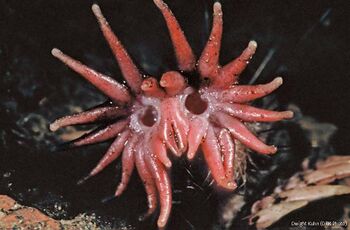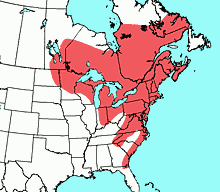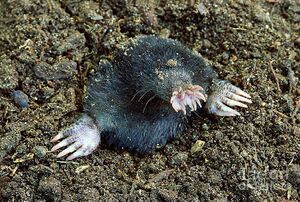Star-nosed mole: Difference between revisions
No edit summary |
No edit summary |
||
| (14 intermediate revisions by the same user not shown) | |||
| Line 21: | Line 21: | ||
| C. cristata | | C. cristata | ||
|} | |} | ||
[[File:Mole nose.jpeg|350px|right]] | |||
== Anatomy == | == Anatomy == | ||
Star-nosed moles are small mammals that have dark, velvety fur, small ears and eyes, and large front paws that are used for digging. Their body size is typically around 15 to 20 centimeters and their weight can vary from around 35 to 75 grams. The star-nosed mole is most easily identifiable by its nose, which has 22 tendrils that the mole uses to sense its environment. Star-nosed moles are functionally blind and rely on their nose for navigation and identification. Even though the size of their nose is around 1 centimeter, it is covered in 25,000 sensory receptor organs known as Eimer's organ. Most moles have many of these sensory organs but star-nosed moles have the highest number of them. For comparison, star-nosed moles have around 6 times more sensory organs in their noses than humans have on their hand, meaning that their noses are highly sensitive. Due to their sensitivity, these receptors aid moles in locating and identifying possible food sources and navigating their environment. The journal ''Nature'' awarded star-nosed moles as the fastest-eating mammal as studies have shown that these moles can take 120 milliseconds to identify and eat food. This is in comparison to the average amount of time, which is reported as 227 milliseconds. | Star-nosed moles are small mammals that have dark, velvety fur, small ears and eyes, and large front paws that are used for digging. Their body size is typically around 15 to 20 centimeters and their weight can vary from around 35 to 75 grams. The star-nosed mole is most easily identifiable by its nose, which has 22 tendrils that the mole uses to sense its environment. Star-nosed moles are functionally blind and rely on their nose for navigation and identification. Even though the size of their nose is around 1 centimeter, it is covered in 25,000 sensory receptor organs known as Eimer's organ. Most moles have many of these sensory organs but star-nosed moles have the highest number of them. For comparison, star-nosed moles have around 6 times more sensory organs in their noses than humans have on their hand, meaning that their noses are highly sensitive. Due to their sensitivity, these receptors aid moles in locating and identifying possible food sources and navigating their environment. The journal ''Nature'' awarded star-nosed moles as the fastest-eating mammal as studies have shown that these moles can take 120 milliseconds to identify and eat food. This is in comparison to the average amount of time, which is reported as 227 milliseconds. | ||
[[File:Mole_range.gif|right]] | |||
== Habitat and range == | == Habitat and range == | ||
Star-nosed [[moles]] live in moist lowland habitats in the eastern half of North America. They can be found in multiple different [[biomes]], including forests, marshes, shrubland, and mountains. They are semi-aquatic mammals and prefer wet environments but have been found in drier habitats as well. Their status in the wild is of least concern and their population is stable. | Star-nosed [[moles]] live in moist lowland habitats in the eastern half of North America. They can be found in multiple different [[biomes]], including forests, marshes, shrubland, and mountains. They are semi-aquatic mammals and prefer wet environments but have been found in drier habitats as well. There are two known subspecies of star-nosed mole. One is ''C. cristata cristata'' and is found in the northern portion of their range and the other is ''C. cristata parva'' which is found in the south and is slightly smaller than the northern subspecies. Two extinct species have been identified from the Pliocene epoch. Star-nosed moles are the last extant members of the ''Condylura'' genus. Their status in the wild is of least concern and their population is stable. | ||
[[ | == Diet and behaviors == | ||
Star-nosed moles are primarily vermivorous, meaning that they feed on [[organisms]] such as [[annelids]] and [[nematodes]]. They also eat [[insects]], larvae, crustaceans, mollusks, and small fish. The most common predators of star-nosed moles include skunks, hawks, owls, foxes, and even large fish species such as pike. These moles are excellent swimmers and forage for food on the bottom of freshwater bodies of water. They also forage in [[soil]] by creating shallow tunnels beneath the surface. Moles can be viewed as pests because their burrowing behavior can damage lawns and gardens. However, moles play an important role in eliminating any potential harmful insects and aerating the soil, creating a more productive environment. Because of the amount of time that moles spend in underground burrows, it has been found that they can survive in environments with little oxygen by effectively reusing the air. They are also able to tolerate higher amounts of carbon dioxide than other [[animals]] due to their blood cells having a special variation of hemoglobin. | |||
[[File:Evs463 star-nosed mole.jpeg|300px|right]] | |||
== Life cycle and reproduction == | == Life cycle and reproduction == | ||
| Line 51: | Line 52: | ||
7. “Star-Nosed Mole.” Wikipedia, Wikimedia Foundation, 19 Mar. 2023, https://en.wikipedia.org/wiki/Star-nosed_mole. | 7. “Star-Nosed Mole.” Wikipedia, Wikimedia Foundation, 19 Mar. 2023, https://en.wikipedia.org/wiki/Star-nosed_mole. | ||
8. Zera, Sean. “Condylura Cristata (Star-Nosed Mole).” Animal [[Diversity]] Web, animaldiversity.org/accounts/Condylura_cristata/. Accessed 11 May 2023. | |||
9. “14 Fascinating Star-Nosed Mole Facts.” Fact Animal, 20 Mar. 2022, factanimal.com/star-nosed-mole/. | |||
Latest revision as of 15:56, 11 May 2023
Taxonomy
| Kingdom | Phylum | Class | Order | Family | Genus | Species | |
|---|---|---|---|---|---|---|---|
| Classification | Animalia | Chordata | Mammalia | Eulipotyphia | Talpidae | Condylura | C. cristata |

Anatomy
Star-nosed moles are small mammals that have dark, velvety fur, small ears and eyes, and large front paws that are used for digging. Their body size is typically around 15 to 20 centimeters and their weight can vary from around 35 to 75 grams. The star-nosed mole is most easily identifiable by its nose, which has 22 tendrils that the mole uses to sense its environment. Star-nosed moles are functionally blind and rely on their nose for navigation and identification. Even though the size of their nose is around 1 centimeter, it is covered in 25,000 sensory receptor organs known as Eimer's organ. Most moles have many of these sensory organs but star-nosed moles have the highest number of them. For comparison, star-nosed moles have around 6 times more sensory organs in their noses than humans have on their hand, meaning that their noses are highly sensitive. Due to their sensitivity, these receptors aid moles in locating and identifying possible food sources and navigating their environment. The journal Nature awarded star-nosed moles as the fastest-eating mammal as studies have shown that these moles can take 120 milliseconds to identify and eat food. This is in comparison to the average amount of time, which is reported as 227 milliseconds.

Habitat and range
Star-nosed moles live in moist lowland habitats in the eastern half of North America. They can be found in multiple different biomes, including forests, marshes, shrubland, and mountains. They are semi-aquatic mammals and prefer wet environments but have been found in drier habitats as well. There are two known subspecies of star-nosed mole. One is C. cristata cristata and is found in the northern portion of their range and the other is C. cristata parva which is found in the south and is slightly smaller than the northern subspecies. Two extinct species have been identified from the Pliocene epoch. Star-nosed moles are the last extant members of the Condylura genus. Their status in the wild is of least concern and their population is stable.
Diet and behaviors
Star-nosed moles are primarily vermivorous, meaning that they feed on organisms such as annelids and nematodes. They also eat insects, larvae, crustaceans, mollusks, and small fish. The most common predators of star-nosed moles include skunks, hawks, owls, foxes, and even large fish species such as pike. These moles are excellent swimmers and forage for food on the bottom of freshwater bodies of water. They also forage in soil by creating shallow tunnels beneath the surface. Moles can be viewed as pests because their burrowing behavior can damage lawns and gardens. However, moles play an important role in eliminating any potential harmful insects and aerating the soil, creating a more productive environment. Because of the amount of time that moles spend in underground burrows, it has been found that they can survive in environments with little oxygen by effectively reusing the air. They are also able to tolerate higher amounts of carbon dioxide than other animals due to their blood cells having a special variation of hemoglobin.

Life cycle and reproduction
Star-nosed moles have a lifespan of around 2 to 4 years. They are known to be serially monogamous, meaning that they stay with their partner for one breeding season. They begin mating in late winter and early spring and give birth to a litter with around 2 to 7 hairless offspring in late spring and early summer. Females give birth to their young in underground tunnels. When the litter is born, their ears, eyes, and star are sealed shut and don't open and become functional until they are around 2 weeks old. Star-nosed moles are considered to be mature when they reach 10 months old.
References
1. Devereaux, Maiah E. M., et al. “Burrowing Star-Nosed Moles (Condylura Cristata) Are Not Hypoxia Tolerant.” The Company of Biologists, The Company of Biologists, 14 Oct. 2021, https://journals.biologists.com/jeb/article/224/19/jeb242972/272464/Burrowing-star-nosed-moles-Condylura-cristata-are.
2. Engelhaupt, Erika. “Inside the Bizarre Life of the Star-Nosed Mole, World's Fastest Eater.” Animals, National Geographic, 3 May 2021, https://www.nationalgeographic.com/animals/article/star-nosed-mole-touch-pain-senses.
3. “The IUCN Red List of Threatened Species.” IUCN Red List of Threatened Species, 7 Aug. 2016, https://www.iucnredlist.org/species/41458/115187740.
4. “Mole.” Encyclopædia Britannica, Encyclopædia Britannica, Inc., https://www.britannica.com/animal/mole-mammal.
5. “Moles.” National Wildlife Federation, http://nwf.org/Educational-Resources/Wildlife-Guide/Mammals/Moles.
6. “Star-Nosed Mole.” Star-Nosed Mole - Facts, Diet, Habitat & Pictures on Animalia.bio, https://animalia.bio/star-nosed-mole.
7. “Star-Nosed Mole.” Wikipedia, Wikimedia Foundation, 19 Mar. 2023, https://en.wikipedia.org/wiki/Star-nosed_mole.
8. Zera, Sean. “Condylura Cristata (Star-Nosed Mole).” Animal Diversity Web, animaldiversity.org/accounts/Condylura_cristata/. Accessed 11 May 2023.
9. “14 Fascinating Star-Nosed Mole Facts.” Fact Animal, 20 Mar. 2022, factanimal.com/star-nosed-mole/.